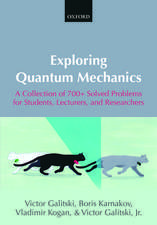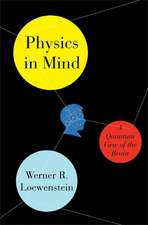Quantum Mechanics: Texts and Monographs in Physics
Autor Boehmen Limba Engleză Paperback – 5 noi 2011
Preț: 402.56 lei
Nou
Puncte Express: 604
Preț estimativ în valută:
77.03€ • 79.59$ • 64.08£
77.03€ • 79.59$ • 64.08£
Carte tipărită la comandă
Livrare economică 19 martie-02 aprilie
Preluare comenzi: 021 569.72.76
Specificații
ISBN-13: 9781461261285
ISBN-10: 1461261287
Pagini: 544
Ilustrații: XVIII, 522 p.
Dimensiuni: 155 x 235 x 29 mm
Greutate: 0.76 kg
Ediția:Softcover reprint of the original 1st ed. 1979
Editura: Springer
Colecția Springer
Seria Texts and Monographs in Physics
Locul publicării:New York, NY, United States
ISBN-10: 1461261287
Pagini: 544
Ilustrații: XVIII, 522 p.
Dimensiuni: 155 x 235 x 29 mm
Greutate: 0.76 kg
Ediția:Softcover reprint of the original 1st ed. 1979
Editura: Springer
Colecția Springer
Seria Texts and Monographs in Physics
Locul publicării:New York, NY, United States
Public țintă
ResearchCuprins
I Mathematical Preliminaries.- I.1 The Mathematical Language of Quantum Mechanics.- I.2 Linear Spaces, Scalar Product.- I.3 Linear Operators, Algebras.- II Foundations of Quantum Mechanics — The Harmonic Oscillator.- II. 1 Introduction.- II.2 The First Basic Assumption of Quantum Mechanics.- II.3 Algebra of the Harmonic Oscillator.- II.4 The Relation between Experimental Data and Quantum-Mechanical Observables.- II.5 The Effect of a Measurement on the State of a Quantum-Mechanical System.- II.6 The Basic Assumptions Applied to the Harmonic Oscillator, and Some Historical Remarks.- II.7 Some General Consequences of the Basic Assumptions of Quantum Mechanics.- II.8 Eigenvectors of Position and Momentum Operators; the Wave Functions of the Harmonic Oscillator.- II.9 Comparison between Quantum and Classical Harmonic Oscillators.- II.10 Basic Assumptions II and III for Observables with Continuous Spectra.- II.11 Position and Momentum Measurements—Particles and Waves.- III Energy Spectra of Some Molecules.- III.1 Transitions between Energy Levels of Vibrating Molecules—The Limitations of the Oscillator Model.- III.2 The Rigid Rotator.- III.3 The Algebra of Angular Momentum.- III.4 Rotation Spectra.- III.5 Combination of Quantum Physical Systems—The Vibrating Rotator.- IV Complete Systems of Commuting Observables.- V Addition of Angular Momenta — The Wigner — Eckart Theorem.- V.1 Introduction—The Elementary Rotator.- V.2 Combination of Elementary Rotators.- V.3 Tensor Operators and the Wigner-Eckart Theorem.- V.4 Parity.- VI Hydrogen Atom — The Quantum-Mechanical Kepler Problem.- VI.1 Introduction.- VI.2 Classical Kepler Problem.- VI.3 Quantum-Mechanical Kepler Problem.- VI.4 Properties of the Algebra of Angular Momentum and the Lenz Vector.- VI.5 The HydrogenSpectrum.- VII Alkali Atoms and the Schrödinger Equation of One-Electron Atoms.- VII.1 The Alkali Hamiltonian and Perturbation Theory.- VII.2 Calculation of the Matrix Elements of the Operator Q?v.- VII.3 Wavefunctions and Schrödinger Equation of the Hydrogen Atom and the Alkali Atoms.- VIII Perturbation Theory.- VIII.1 Perturbation of the Discrete Spectrum.- VIII.2 Perturbation of the Continuous Spectrum—The Lippman-Schwinger Equation.- IX Electron Spin.- IX.1 Introduction.- IX.2 The Fine Structure—Qualitative Considerations.- IX.3 Fine-Structure Interaction.- IX.4 Fine Structure of Atomic Spectra.- IX.5 Selection Rules.- IX.6 Remarks on the State of an Electron in Atoms.- X Indistinguishable Particles.- X.1 Introduction.- XI Two-Electron Systems — The Helium Atom.- XI.1 The Two Antisymmetric Subspaces of the Helium Atom.- XI.2 Discrete Energy Levels of Helium.- XI.3 Selection Rules and Singlet-Triplet Mixing for the Helium Atom.- XI.4 Doubly Excited States of Helium.- XII Time Evolution.- XII.1 Time Evolution.- XII.A Mathematical Appendix: Definitions and Properties of Operators That Depend upon a Parameter.- XIII Change of the State by Dynamical Law and by the Measuring Process — The Stern — Gerlach Experiment.- XIII.1 The Stern-Gerlach Experiment.- XIII.A Appendix.- XIV Transitions in Quantum Physical Systems — Cross Section.- XIV.1 Introduction.- XIV.2 Transition Probabilities and Transition Rates.- XIV.3 Cross Sections.- XIV.4 The Relation of Cross Sections to the Fundamental Physical Observables.- XIV.5 Derivation of Cross-Section Formulas for the Scattering of a Beam off a Fixed Target.- XV Formal Scattering Theory and Other Theoretical Considerations.- XV.1 The Lippman-Schwinger Equation.- XV.2 In-States and Out-States.- XV.3 The S-Operator andthe Møller Wave Operators.- XV.A Appendix.- XVI Elastic and Inelastic Scattering for Spherically Symmetric Interactions.- XVI.1 Partial-Wave Expansion.- XVI.2 Unitarity and Phase Shifts.- XVI.3 Argand Diagrams.- XVII Free and Exact Radial Wave Functions.- XVII.1 Introduction.- XVII.2 The Radial Wave Equation.- XVII.3 The Free Radial Wave Function.- XVII.4 The Exact Radial Wave Function.- XVII.5 Poles and Bound States.- XVII.6 Survey of Some General Properties of Scattering Amplitudes and Phase Shifts.- XVII.A Mathematical Appendix.- XVIII Resonance Phenomena.- XVIII.1 Introduction.- XVIII.2 Time Delay and Phase Shifts.- XVIII.3 Causality Conditions.- XVIII.4 Causality and Analyticity.- XVIII.5 Brief Description of the Analyticity Properties of the S-Matrix.- XVIII.6 Resonance Scattering—Breit-Wigner Formula for Elastic Scattering.- XVIII.7 The Physical Effect of a Virtual State.- XVIII.8 Argand Diagrams for Elastic Resonances and Phase-Shift Analysis.- XVIII.9 Comparison with the Observed Cross Section: the Effect of Background and Finite Energy Resolution.- XIX Time Reversal.- XIX.1 Space-Inversion Invariance and the Properties of the S-Matrix.- XIX.2 Time Reversal.- XIX.2 Appendix to Section XIX.2.- XIX.3 Time-Reversal Invariance and the Properties of the S-Matrix.- XX Resonances in Multichannel Systems.- XX.1 Introduction.- XX.2 Single and Double Resonances.- XX.3 Argand Diagrams for Inelastic Resonances.- XXI The Decay of Unstable Physical Systems.- XXI.1 Introduction.- XXI.2 Lifetime and Decay Rate.- XXI.3 The Description of a Decaying State and the Exponential Decay Law.- XXI.4 Decay Rate.- XXI.5 Partial Decay Rates.- Epilogue.



















